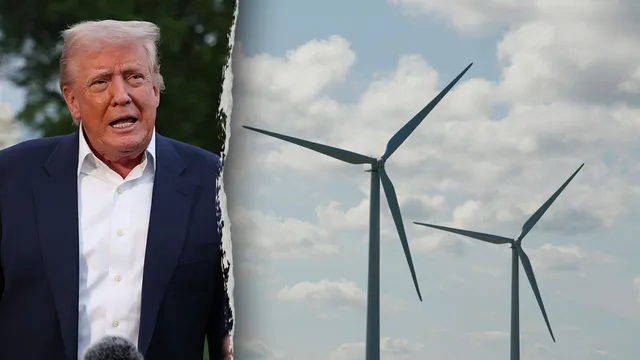
Seventeen states challenge Trump's offshore wind energy halt
2025-05-09 21:03- The Trump administration's executive order halted federal permitting for offshore wind projects.
- Seventeen states and DC filed a lawsuit against the administration, claiming economic and job losses due to halted projects.
- The lawsuit reflects a significant opposition from several states towards federal energy policies favoring fossil fuels.
Express your sentiment!
Insights
In January 2021, the District of Columbia along with 17 states filed a lawsuit against the Trump administration regarding its executive order halting federal offshore wind energy projects. The legal action arose from concerns that Trump's policy would severely impede progress on developing renewable energy sources, which are vital for job creation and energy generation. The plaintiffs claimed that the executive order issued on the president's first day in office was not legally justified and disrupted millions of dollars already invested in offshore wind projects where development was in various stages of approval. The lawsuit highlighted significant potential economic repercussions, including job losses and diminished investment in clean energy infrastructure. The Wind Directive, as outlined in the lawsuit, instructed federal agencies to refrain from issuing any new approvals, permits, or leases related to both onshore and offshore wind projects until a comprehensive review of federal wind leasing practices was completed. Critics argued that this review was unnecessary and duplicative of already existing legal requirements and would result in an indefinite halt of advancements in renewable energy projects. Attorney General Andrea Joy Campbell of Massachusetts underscored the detrimental impact on jobs and economic recovery. She stated that halting wind energy development via these orders contradicts the need for reliable domestic energy. Responses from state officials emphasized their commitment to pursue clean energy goals despite federal intervention. New Jersey Governor Phil Murphy expressed that his state was striving towards its 100% clean energy target by 2035, stating that wind power is essential to achieving this goal. California's Attorney General Rob Bonta condemned Trump's directive as reckless, indicating that it would reverse years of progress in clean energy initiatives. Rhode Island Attorney General Peter Neronha also criticized the administration's intentions, insisting that it was expected given Trump's known stance against renewable energy development. The lawsuit filed in the U.S. District Court for Massachusetts demanded judicial intervention to deem the executive order unlawful and halt its implementation. This legal battle illustrates the significant clash between state interests in pursuing renewable energy and a federal administration perceived to be favoring fossil fuels over clean alternatives. The outcome of the lawsuit could have broad implications for the future of offshore wind energy in the U.S., especially in light of the environmental and economic stakes raised by the plaintiff states.
Contexts
The history of wind energy development in the United States is a story of innovation and progress that spans over a century. The first recorded use of wind energy in the U.S. dates back to the late 19th century when windmills were used primarily for agricultural purposes, such as pumping water and grinding grain. Advances in turbine technology in the 1930s led to the construction of larger wind generators that were capable of producing electricity. However, the rapid expansion of fossil fuels post-World War II overshadowed wind energy, leading to a decline in its use throughout the mid-20th century. Despite the stagnation during the mid-1900s, the energy crises of the 1970s rekindled interest in renewable energy sources, including wind. Significant government investments and subsidies were directed towards research and development in wind technology. This period also saw the establishment of wind farms, primarily in California, which became the epicenter for wind energy development in the U.S. The 1980s and 1990s marked a pivotal shift as advancements in turbine design and technology improved efficiency and lowered costs, making wind energy more competitive in the energy market. Entering the 21st century, wind energy in the U.S. underwent a remarkable transformation, supported by favorable policies such as the Production Tax Credit and Renewable Portfolio Standards. States like Texas, Iowa, and California emerged as leaders in wind energy capacity. By the end of the 2010s, wind power had grown to become one of the leading sources of renewable electricity generation, contributing significantly to the U.S. energy mix. The push for cleaner energy sources in response to climate change has further accelerated the growth of wind energy, with new technologies such as larger turbines and offshore wind farms gaining momentum. As of 2025, the future of wind energy in the U.S. remains bright, with continued investments and advancements expected to play a crucial role in meeting renewable energy goals set forth by both state and federal policies. The evolution of wind energy highlights the importance of innovation and sustainability in addressing energy needs while minimizing environmental impacts. The history of wind energy development is not just a tale of technology but a testament to the human commitment to finding solutions to the challenges of energy production and climate change.